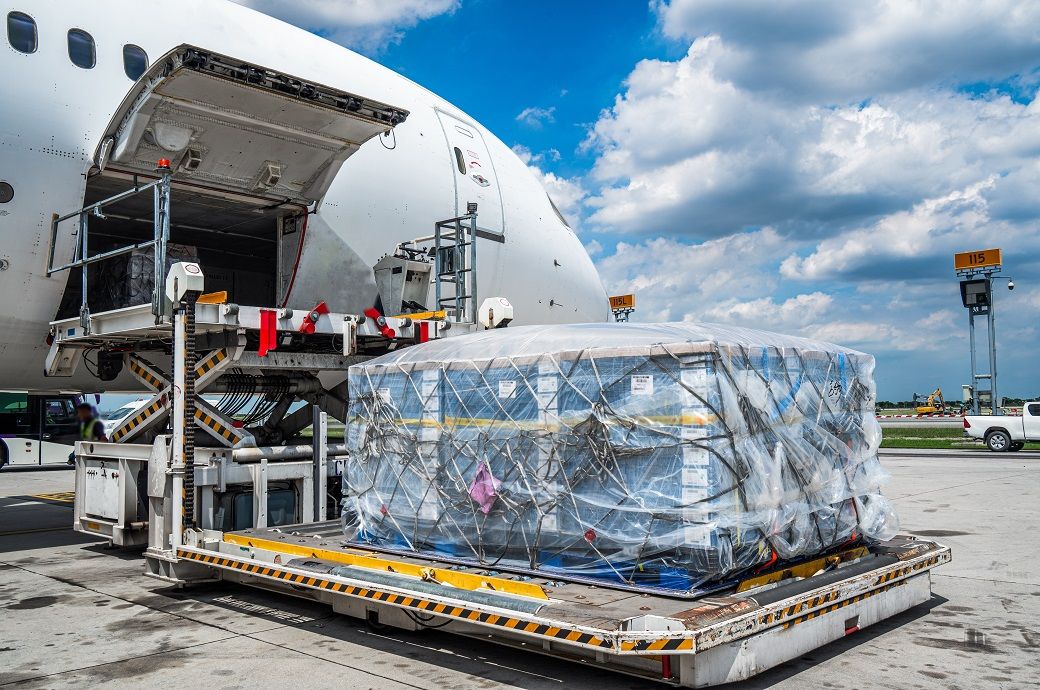Fashion
Global air freight grows in Aug, yet pricing pressures deepen

Despite steady growth in demand, accompanied by a 4 per cent YoY increase in available capacity, global average spot rates fell for the fourth straight month, slipping 3 per cent to $2.55 per kg in August. The decline is likely sharper once currency effects are considered, with the US dollar losing 4 per cent against other currencies in the past year, Xeneta said in a press release.
Shift in trade flows may also be weighing on rates. For example, China–US air cargo was priced at $4.3 per kg in August, but many e-commerce shipments were re-directed to the China–Europe corridor due to US de minimis bans, where rates stood at $3.65 per kg. Such reallocation drags down the global average. A 7 per cent drop in jet-fuel prices may also have helped ease airlines’ costs, muting pressure on rates for now.
Global air cargo demand grew 5 per cent YoY in August for a second month, but spot rates fell 3 per cent to $2.55 per kg, reflecting fragile market conditions.
Trade shifts, US de minimis bans, and a 7 per cent drop in jet fuel shaped flows, while e-commerce offered support.
Analysts caution uncertainty, weak sentiment, and tariff impacts may hinder sustainable growth despite current demand resilience.
The rate decline extended across most major trade lanes, with Southeast Asia–North America and Europe routes seeing the sharpest falls, down over 20 per cent YoY to $4.8 and $3.05 per kg, respectively, as capacity pressures eased. Northeast Asia performed slightly better, with rates to North America down 8 per cent YoY at $4.76 per kg and to Europe holding steady at $4.01 per kg, though backhaul prices slipped 13 per cent on continued trade imbalances. The Transatlantic corridor was the only exception, recording a 5 per cent YoY rise to $1.82 per kg, albeit a marked slowdown from July’s near 20 per cent surge.
“It is often said that airfreight is a bellwether for macroeconomics, but I don’t think it is at the moment,” said Niall van de Wouw, chief airfreight officer at Xeneta. “Right now, volumes are certainly not as bad as people feared, but also not as good as people hoped. In our April data, on the back on the US administration’s ‘Liberation Day’ tariffs announcement, we asked ‘how bad will it get?’ for air cargo demand. We still cannot answer that question.”
“More than ever, shippers are falling into three categories right now,” added van de Wouw. “There are those who will always say ‘no way’ to airfreight because their products simply cannot justify the higher cost of air versus ocean freight. Then there are traditional air cargo customers who always ship goods by air because of its speed and value for their high-priced or more perishable or time-sensitive products. Between these two views sits a bigger group of shippers who will use ocean to move their goods if they can, and airfreight if they must. It is this segment of the market which is driving the upturn in airfreight demand we are seeing.”
E-commerce has been a stabilising force since 2023, driving double-digit monthly growth in 2024. But the removal of the US de minimis threshold for duty-free imports is reshaping flows. While aimed at large Chinese platforms, the changes affect B2B shipments significantly, adding administrative burdens and costs.
“Many SMEs are reacting to these changes, and while B2C may remain resilient, B2B flows will face greater challenges,” van de Wouw observed.
Looking ahead, Xeneta warns that falling purchasing managers’ indices in major exporting economies, weakening US consumer sentiment, and the end of de minimis exemptions will continue to add volatility.
“Uncertainty seems set to remain with so many questions unanswered. The predictions are concerning but, because of this uncertainty, the hurt for airfreight has been softened and delayed. For how much longer anyone’s guess,” van de Wouw concluded.
Fibre2Fashion News Desk (SG)
Fashion
China’s HSG buys controlling stake in Golden Goose

Published
December 19, 2025
Chinese Global investment firm HSG has acquired a controlling stake in Italian sneaker label Golden Goose, in one of the biggest Chinese investments in a European luxury brand.
Temasek, a global investment company, and a fund managed by its wholly-owned asset manager, True Light Capital, will acquire a minority stake. US investment fund Permira will remain committed as a strategic minority shareholder, continuing its successful partnership with Golden Goose, according to a press release from the Venice-based sneaker brand.
The deal ends months of speculation that Golden Goose was about to be sold to a Chinese investor.
Financial terms of the transaction were not disclosed. The transaction is subject to customary closing conditions and regulatory approvals and is currently expected to close within the summer of 2026. Golden Goose S.p.A. expects its €480.0 million Senior Secured Floating Rate Notes due 2031 to be redeemed in full.
Golden Goose has been the fastest growing Italian fashion label in the past half-decade, stunning observers with its exceptional performance. Since 2020, the group has delivered consistent, strong, and profitable growth, with revenues increasing from €266 million in FY 2020 to €655 million in FY 2024. During this period, the group has accelerated its direct-to-consumer (DTC) channels, launched its Forward Store concept, diversified its product assortment, and invested significantly in ‘Co-Creation’ experiences, deepening connections with its customers worldwide.

This investment comes amid a period of strong financial performance for Golden Goose. In the nine months ending September 2025, the group reported double-digit growth across regions. Revenues rose 13% year-on- year, driven by 21% growth in its DTC channel and an expanded store network, which reached 227 directly operated stores, up from 97 in 2019.
The investment is underpinned by a strong strategic and cultural fit with Golden Goose’s growth ambitions. Drawing on the new investors’ combined experience and track records investing in international luxury and consumer technology brands, such as Moncler and Ermenegildo Zegna group by Temasek, and ByteDance, Pop Mart, RedNote, and Marshall by HSG, they will support Golden Goose’s international ambitions as a leading next-generation luxury brand, while preserving and continuing to invest in Golden Goose’s Made in Italy roots.
Silvio Campara, Golden Goose’s hard charging CEO, will continue to lead the group as chief executive officer, alongside the existing leadership team. Marco Bizzarri, currently a non- executive director on the Golden Goose board, will become non-executive chairman. He brings significant industry expertise, shaped by his leadership of globally renowned luxury brands including Gucci, Bottega Veneta, and Kering, and will play an important role in accelerating Golden Goose’s next phase of global expansion.

“We are delighted to welcome HSG and Temasek as strategic partners to Golden Goose as we step up our global ambitions as a leading international luxury brand. Their investment is yet another vote of confidence in the success of our model at the intersection of luxury, lifestyle, and sportswear, beloved by a growing, global community of dreamers. With their experience of scaling international leaders across luxury and the broader business spectrum, HSG and Temasek will help us unlock the vast opportunity ahead for Golden Goose. We are grateful to Permira for being integral partners to our successful journey so far and are delighted they will remain valued partners alongside HSG and Temasek,” said Campara.
“Golden Goose stands for love, empathy, authenticity and a powerful sense of community in today’s luxury landscape,” added Jiajia Zou, Partner at HSG. “We feel deeply privileged to partner with Temasek and Permira, together with Silvio and his talented team to support the brand as it enters its next exciting chapter of growth- especially internationally- while preserving and celebrating what makes Golden Goose so uniquely Italian. We look forward to contributing our global experience, resources, and deep respect for the brand’s heritage, with the shared ambition of bringing the unique joy and spirit of Golden Goose to consumers around the world, for generations to come.”
In addition, Francesco Pascalizi and Tara Alhadeff, partners at Permira, commented: “Golden Goose has led the way in defining what it is to be a next-gen luxury brand for two decades now. They have built a unique community of GG-lovers around the world whilst also building a robust and high performing business. Against a challenging backdrop for the luxury industry in 2024 and 2025, Silvio and his talented team have continued to deliver strong performance and healthy growth, proving that Golden Goose is a brand that can stand the test of time.”
Copyright © 2025 FashionNetwork.com All rights reserved.
Fashion
Nigeria’s textile imports up 47.43% YoY in Jan-Sept 2025

The country imported textile and textile materials worth N 228.83 billion in the first quarter (Q1) this year, N 337.12 billion in Q2 and N 248.32 billion in Q3.
Industry experts blame policy failure, weak execution of credit initiatives, abandonment of promised institutional reforms, pervasive corruption and structural bottlenecks like weak cotton farming, insecurity and the inability to scale locally-produced polyester for the decline, according to Nigerian media reports.
Nigeria’s textile imports rose to N 814.27 billion in January-September 2025—a 47.43-per cent YoY rise despite repeated government claims of the sector’s revival.
Rising imports indicate a weak domestic textile industry.
Industry experts blame policy failure, weak execution of credit initiatives, abandonment of promised institutional reforms, pervasive corruption and structural bottlenecks for the fall.
Hamma Kwajaffa, director general of the Nigerian Textile Manufacturers Association, lamented that the 10-per cent tax on imported textiles—which was introduced when the ban on textile imports was lifted so that the amount collected can be ploughed into domestic textile production—has not been directed to improve the private textile sector.
Kwajaffa pointed to the failure to create a dedicated textile development fund domiciled with the Bank of Industry.
Conflicting positions among top officials had stalled any action related to the sector and repeated workshops and announcements without execution had yielded no tangible outcome, Kwajaffa added.
Fibre2Fashion News Desk (DS)
Fashion
Confident Meadowhall enjoys a year of strength

Published
December 19, 2025
There’s been quite a few end-of-year updates from shopping centres and all of them are upbeat after a busy 2025.
Sheffield’s Meadowhall is one of them, noting it has been a strong year of exchanges on new leases covering 300,000 sq ft of the destination, 80% retail and 20% hospitality, including renewals from 19 tenants.
It said visitor numbers “have also remained consistently high”, headlined by its busiest Black Friday weekend in six years (262,981 visitors across the three days), while October’s school half-term was also the strongest in six years (457,000 visitors representing a 9.7% year-on-year increase).
Meanwhile, commercial brand activations continued to “perform effectively” throughout 2025, including standout initiatives from Trinny London and Jo Malone.
And, of course, new openings and expansions are the lifeblood of any centre with Meadowhall announcing fast-expanding novelty retailer Miniso has just joined its roster while fashion lifestyle brand TK Maxx has extended its presence there, “concluding a strong year of leasing activity and retail performance”.
TK Maxx has added an adjacent unit to create a 19,000 sq ft space, complete with a 173-ft fully-glazed frontage on the Upper Level The Gallery, showcasing its mix of branded fashion, beauty, homeware, and accessories.
Miniso, meanwhile, has opened a 1,759 sq ft store on Lower Level High Street, introducing its range of lifestyle, homeware, and technology products, alongside the brand’s character collections.
These additions follow several major openings in 2025, including beauty majors Sephora and Superdrug.
These introductions round off a period in which several tenants have invested significantly in upgrading and expanding their stores. More than £47 million has been spent by brands alone across 2024 and 2025, with more than a third of Meadowhall’s operators undertaking new fitouts and refurbishments in that time.
Looking ahead to 2026, operator British Land said more than 25 brands have already committed, and will be bringing a further £8 million of investment to the centre.
Louisa Holmes, Asset Director at operator British Land, said: “This year’s level of investment, from new arrivals and long-standing tenants, reflects the confidence brands have in Meadowhall as a critical part of their national portfolio. In addition to that, the centre’s success means our brands are effectively competing to bring the best and latest shop fits and concepts here, elevating the experience for our visitors.”
Copyright © 2025 FashionNetwork.com All rights reserved.
-

 Business6 days ago
Business6 days agoHitting The ‘High Notes’ In Ties: Nepal Set To Lift Ban On Indian Bills Above ₹100
-

 Politics1 week ago
Politics1 week agoTrump launches gold card programme for expedited visas with a $1m price tag
-

 Sports1 week ago
Sports1 week agoU.S. House passes bill to combat stadium drones
-

 Sports1 week ago
Sports1 week agoPolice detain Michigan head football coach Sherrone Moore after firing, salacious details emerge: report
-

 Fashion1 week ago
Fashion1 week agoTommy Hilfiger appoints Sergio Pérez as global menswear ambassador
-

 Business1 week ago
Business1 week agoCoca-Cola taps COO Henrique Braun to replace James Quincey as CEO in 2026
-

 Fashion1 week ago
Fashion1 week agoBrunello Cucinelli lifts 2025 revenue growth forecast to up to 12%
-

 Sports4 days ago
Sports4 days agoJets defensive lineman rips NFL officials after ejection vs Jaguars


















